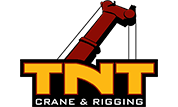The Logistics Behind Moving Heavy Equipment with Cranes
Lift Planning | Oct 9 / 25
Moving heavy equipment requires more than just lifting; it involves careful planning, coordination, and the right equipment for the job. Every detail matters, from the weight of the load to the conditions of the site. At TNT Crane & Rigging, we specialize in helping customers plan and execute complex projects safely and efficiently. That is why we have outlined the logistics behind moving heavy equipment with cranes.
Learn how to transport a crawler crane to your jobsite.
What Goes into Planning a Heavy Equipment Move?
Behind every successful crane lift is a detailed plan. Heavy equipment cannot just be picked up and moved without considering how it will affect the site and everyone working on it. By addressing these details ahead of time, projects are more likely to run smoothly and without unnecessary delays.
Site Assessment and Preparation
Before creating a plan for lifting heavy machinery, the site must be fully assessed. This includes checking ground conditions, accessibility, and identifying any potential obstacles that might interfere with crane operations. Proper preparation ensures the crane can be positioned correctly and that equipment can be moved without creating unnecessary risks.
Choosing the Right Crane
Different projects call for different types of cranes. Whether it is using a mobile crane for flexibility, performing heavy lifts with a crawler crane for maximum stability, or transporting oversized loads with a larger crane, selecting the right equipment is one of the most important steps. The size, reach, and lifting capacity of the crane all play a role in making sure the job is handled properly.
Coordination and Safety
Moving heavy equipment requires clear communication between crane operators, riggers, and other workers onsite. Coordinating each step of the process helps ensure that the lift is completed efficiently and without incident. Safety measures, such as rigging inspections and lift plans, also play a key role in preventing accidents and protecting valuable equipment.
Transport and Placement
Once the equipment is lifted, the final challenge is moving and positioning it correctly. Careful planning ensures that the equipment reaches its destination securely, whether it is being set in place for installation or transported to a new location.
At TNT Crane & Rigging, we provide the crane rental services and expertise needed to handle even the most complex heavy equipment moves. Contact our expert team today to learn more about how we can help with your next lifting project.
Moving heavy equipment requires more than just lifting; it involves careful planning, coordination, and the right equipment for the job. Every detail matters, from the weight of the load to the conditions of the site. At TNT Crane & Rigging, we specialize in helping customers plan and execute complex projects safely and efficiently. That is why we have outlined the logistics behind moving heavy equipment with cranes.
Learn how to transport a crawler crane to your jobsite.
What Goes into Planning a Heavy Equipment Move?
Behind every successful crane lift is a detailed plan. Heavy equipment cannot just be picked up and moved without considering how it will affect the site and everyone working on it. By addressing these details ahead of time, projects are more likely to run smoothly and without unnecessary delays.
Site Assessment and Preparation
Before creating a plan for lifting heavy machinery, the site must be fully assessed. This includes checking ground conditions, accessibility, and identifying any potential obstacles that might interfere with crane operations. Proper preparation ensures the crane can be positioned correctly and that equipment can be moved without creating unnecessary risks.
Choosing the Right Crane
Different projects call for different types of cranes. Whether it is using a mobile crane for flexibility, performing heavy lifts with a crawler crane for maximum stability, or transporting oversized loads with a larger crane, selecting the right equipment is one of the most important steps. The size, reach, and lifting capacity of the crane all play a role in making sure the job is handled properly.
Coordination and Safety
Moving heavy equipment requires clear communication between crane operators, riggers, and other workers onsite. Coordinating each step of the process helps ensure that the lift is completed efficiently and without incident. Safety measures, such as rigging inspections and lift plans, also play a key role in preventing accidents and protecting valuable equipment.
Transport and Placement
Once the equipment is lifted, the final challenge is moving and positioning it correctly. Careful planning ensures that the equipment reaches its destination securely, whether it is being set in place for installation or transported to a new location.
At TNT Crane & Rigging, we provide the crane rental services and expertise needed to handle even the most complex heavy equipment moves. Contact our expert team today to learn more about how we can help with your next lifting project.

